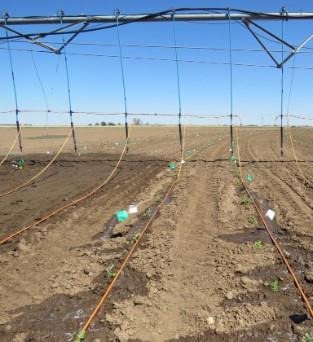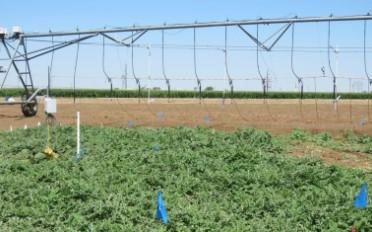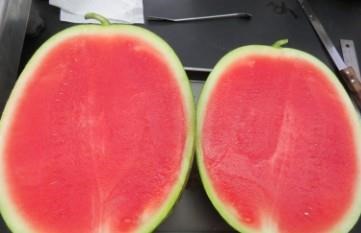Results of the second year of a field study on mobile drip irrigation use with watermelons show greater yields, higher biomass accumulation, less water use and greater water-use efficiency.
The project investigating irrigation methods and scheduling is led by AgriLife Research’s Qingwu Xue, Ph.D., crop physiologist with the Department of Soil and Crop Sciences, and Charlie Rush, Ph.D., retired plant pathologist, both in Amarillo. They are collaborating with U.S. Department of Agriculture–Agricultural Research Service scientists Susan O’Shaughnessy, Ph.D., and Paul Colaizzi, Ph.D., and industry partners.
Funding is partially provided by the Irrigation Innovation Consortium at Colorado State University, the Texas Department of Agriculture, and the Texas A&M AgriLife Institute for Advancing Health Through Agriculture. This project aims to investigate the potential of producing specialty crops under irrigation for fresh market sales in the Texas High Plains.
“Using less water is extremely attractive to irrigated crop production in the High Plains region because the resources from the Ogallala Aquifer are continuously depleting,” Xue said. “Although watermelon yields vary, the melon quality did not change under different irrigation methods. This means that sprinkler irrigation does not have a negative effect on watermelons.”
Irrigation systems in the study
While stationary drip irrigation — subsurface or surface — is preferred and performs best on vegetables and melons, most High Plains producers have already invested in center pivot sprinkler irrigation for traditional crops.
The research team is studying the performance of a system that combines the benefits of the center pivot and drip irrigation. They compare mobile drip irrigation, MDI, and low-elevation sprinkler application, LESA, irrigation systems against traditional surface drip irrigation. The study also uses different irrigation scheduling methods to determine irrigation timing and amount.
The MDI system attaches to existing center pivot irrigation systems and applies water directly to the soil surface as the driplines are dragged across the field to provide uniform wetness.
The LESA sprinkler irrigation system represents traditional irrigation in most fields. It includes spray nozzles that hang from the center pivot and place the water application about 2 feet from the soil surface.

The two three lines on the left hand irrigated the young melon plants through the traditional low energy spray drop nozzles, wetting the entire soil surface, while the three lines on the right side watered the plants through long dragging hoses and only in the plant rows.

Dragging drip lines were attached to the traditional center pivot system and they allowed a greater water-use efficiency and more fruit production than the traditional center pivot drop nozzles.
Second year of study shows more benefits of mobile drip irrigation
The 2022 watermelon study had two field sites at the USDA-ARS and AgriLife Research facilities at Bushland.
One site focused on a direct comparison of three irrigation methods — MDI, LESA and surface or stationary drip with plastic mulch — using neutron probes to measure soil moisture and help determine irrigation timing. The second site compared MDI and LESA irrigations and two advanced irrigation scheduling methods as well as different distances between MDI drop hoses.
For both sites, plants were transplanted at the end of May, and fruit harvests were from the end of August to the middle of September. The research team made regular field measurements and observations during the growing season that involved training postdoctoral scientists, technical staff, and graduate and undergraduate students.

Seedless watermelons grown by Texas A&M AgriLife Research faculty as a part of an irrigation study.
The crop physiology team consisted of Xue, two postdoctoral research associates, Andrea Leiva Soto, Ph.D., and Rajan Shrestha, Ph.D., and two student workers. This team conducted regular physiological measurements, biomass sampling, and fruit harvesting and quality analysis.
The plant pathology group, including Fekede Workneh, Ph.D., AgriLife Research senior research scientist; Jewel Arthur, a research associate, and two student workers, closely monitored plant disease incidents.
The results of the 2022 study demonstrated that growing watermelons in the High Plains is a good alternative under a center pivot irrigation system, Xue said.
“Watermelon is a relatively short-season crop compared to irrigated corn,” he said. “It took less than 100 days to grow watermelon (end of May to mid-September) in the last two years. The total amount of irrigation during the growing season was less than 17 inches. A typical 110-day corn requires over 20 inches of irrigation water. Therefore, growing watermelons potentially can save up to 4 inches of irrigation water compared to irrigated corn.”
The results by the numbers
The results of the 2022 study demonstrated more benefits for using MDI irrigation, based on the analysis conducted by Leiva Soto.
- The MDI method resulted in 2-4 inches of irrigation savings during the watermelon growing season, compared to LESA irrigation.
- In the north section, plant biomass and leaf area were two times greater in MDI than in LESA irrigation.
- More water was used by LESA for the same amount of production. So, MDI had higher water-use efficiency.
- Plants under MDI had greater photosynthetic rate, transpiration, stomatal conductance, and water-use efficiency at the leaf level.
- In the south section, the fruit yield per plant was 19.8 pounds per plant under LESA, and 35.2 pounds under MDI and traditional surface drip. In the north section, fruit yield per plant was 39.4 pounds under LESA and 41.1 pounds under MDI.
- In the south section, the number of fruits per plant was 1.1 under LESA, 1.8 under MDI and 2.4 under surface drip. In the north section, the number of fruits per plant was 2.8 under LESA and 2.6 under MDI.
- The single fruit weight was 18.5 pounds under LESA, 19.8 pounds under MDI, and 14.5 pounds under surface drip in the south section. The single fruit weight was 14.7 pounds under LESA and 15.8 pounds under MDI in the north section.
- The fruit sugar content ranged 11-12% and did not differ among irrigation treatments.
Xue said lower yields in the south section were due to irrigation pipeline issues, which caused the plots there to miss two irrigations in the middle of July. Nevertheless, MDI irrigation showed consistent benefits at both sites.
“The 2022 summer crop season was characterized as windy, dry and hot in June and July,” Xue said. “As a result, MDI irrigation showed the advantage of reducing water loss because the water was directly applied to the crop root zone. The watermelon yield difference between the two sites was contributed by irrigation management.”
Source : tamu.edu